Concentration (1958-1973)
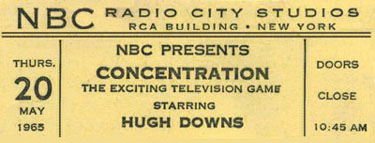
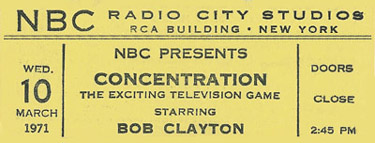
Hugh Downs was the announcer/sidekick on Jack Paar’s Tonight Show when NBC asked him to also host a daytime game show. It made for a long workday but Downs agreed and Concentration went on the air. It was a very simple game of memory, strategy and perception, and you won if you could uncover the pieces of a hidden rebus and solve it.
There was also a prime time version of Concentration in 1958 and 1961. At first, it was jazzed up with more lights and music, and Downs was ignominiously passed over for the moderator position, which went to Jack Barry who, with his partner Dan Enright, owned and produced the show. When ratings proved disappointing, NBC decided it needed Downs after all, and he agreed on the condition that they remove the “improvements.” This was done, he took over the nighttime version…and its ratings went up.
Downs was very proud and protective of the series. At a time when it was revealed that certain other game shows were rigged and their handlers — Jack Barry and Dan Enright — were being shamed out of the business, Downs happily pointed out that Concentration was practically rig-proof. Even if someone had given a contestant the answer, they couldn’t do much with it. If they solved the puzzle too early, they didn’t win much in the way of prizes. If they waited until the bounty grew to a hefty size, they risked losing control of the game board, which meant that their opponent would win. And at no point could the winnings equal the kind of megabucks that characterized the shows that were fixed. Nevertheless, Downs himself was known to skulk around and investigate to make sure the game he was fronting was as honest as he represented it to be. That honesty was one of the things that kept Concentration on the air for so long. When the game show scandals hit, NBC quietly bought out the interests of Barry and Enright, removed all mention of them from the show’s history, and kept things running.
After Paar left The Tonight Show, Downs took over The Today Show…but he retained the Concentration job until 1969 when the workload got to be too much for him. When he announced his desire to quit the game show, the network asked him to stay on for an extra four months past the expiration of his contract to help them with an important ratings period. Downs agreed on the condition that the show’s announcer, Bob Clayton, be given the host’s job after him. Downs and Clayton were friends, and Clayton had filled in for Downs a few times and done the show the way Downs felt it should be done. As someone who had himself been typecast for a time as an off-camera announcer, Downs felt that Clayton was deserving of the on-camera gig, so he made the condition. NBC agreed and Clayton got the assignment…but not for long. Another Tonight Show sidekick, Ed McMahon, had been hosting Snap Judgment, another game show for NBC. When it was cancelled, Clayton was booted from Concentration and McMahon installed in his place. Downs was furious at the double-cross. Several months later, realizing McMahon wasn’t working out, an NBC executive actually phoned Downs and asked, “Do you know how we can reach Bob Clayton?” Downs later said he tried not to be too smug.
Clayton returned as emcee until the show was cancelled in 1973. Jack Narz hosted a syndicated revival that ran from 1973 to 1979 and then Alex Trebek hosted Classic Concentration, which ran from 1987 to 1991.
Original Amateur Hour, The
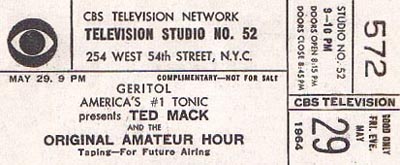
It always struck me as a little odd that everyone on Ted Mack’s show had talent except Ted Mack. I also don’t recall ever seeing anyone on that show whose talents, real though they may have been, seemed likely to lift them to any other spot in the great pantheon of show business. A few of the folks who appeared on The Original Amateur Hour later had careers but not because of that show. I mean, Robert Klein appeared on Mr. Mack’s show as part of a doo-wop group called The Teen-Tones, but that didn’t lead to a single job. Moreover, the success rate, given how long the show was on the air and how many talented amateurs it showcased, was amazingly low. How did it stay on the air, between radio and TV, for almost 40 years? I’d guess that the early part of the run had appeal because America was still climbing out of The Great Depression, and there was a certain thrill to listening to some poor kid get a chance to play his ocarina on radio and maybe, just maybe, get discovered and strike it rich.
But I can tell you what kept the show on the air its last decade or so, and the magic word is right there on the above ticket: Geritol. Its makers had discovered that certain kinds of shows were very good for selling their product. Today, one hears a lot about demographics and advertisers who seek a young audience. Geritol did the opposite: They wanted to reach people who might purchase “America’s #1 tonic,” which meant mostly older folks. To that end, they sponsored a number of shows — Lawrence Welk’s being the prime example — even when the overall ratings weren’t grand. Today, a network might refuse the business (as ABC eventually cancelled Welk, despite Geritol’s wishes) on the grounds that a couple of older-skewing shows can drag down the rest of the schedule. But back then, individual sponsors had more clout, especially over certain time slots. So Ted Mack stayed on, despite a lack of talent or, at times, much of an audience.
Chicken Soup
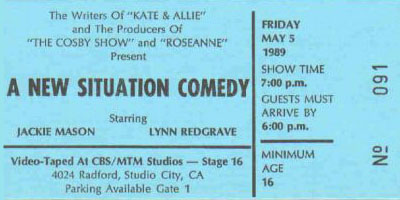
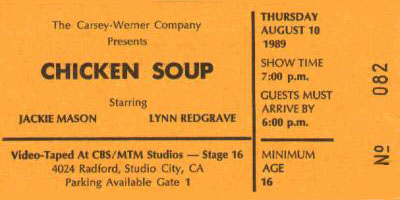
In the late eighties, comedian Jackie Mason made a comeback of sorts with a one-man show that played Broadway and theaters around the nation. Entitled, The World According to Me, it was kind of a “best of” of stand-up material he’d been performing for several decades and it was very funny. ABC grabbed him up for a situation comedy that debuted on September 12, 1989 under the name, Chicken Soup. As you can see from the first ticket above, they were taping in May without having settled on that name.
On Chicken Soup, Mason played Jackie Fisher, a single Jewish man who stumbles into an odd relationship with an Irish-Catholic widow with three children. Lynn Redgrave played the widow and critics were almost unanimous in remarking how unconvincing the stars were as a couple. It was difficult to imagine the on-screen Jackie Mason being in love with anyone but certainly not Ms. Redgrave. Never have the co-stars of a situation comedy seemed so remote from one another. Only when the scripts allowed Mason to sneak in a bit of his stand-up style did the series show any life. But that didn’t happen often enough for the show to survive and it only ran eleven episodes.
Dick Van Dyke and the Other Woman
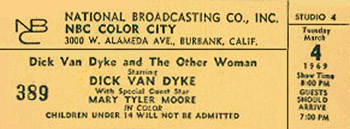
In 1969, with their film careers not going quite the way they wanted, Dick Van Dyke and Mary Tyler Moore reunited for an hour of songs and sketches themed around the various aspects of dating and marriage. Critics raved about Dick Van Dyke and the Other Woman and audiences loved it. It led to offers for both Dick and Mary to return to series television and soon after, Mary was working on The Mary Tyler Moore Show. And a year after that made a hit, Dick Van Dyke was doing The New Dick Van Dyke Show.
Mary Tyler Moore Hour, The


A few years after The Mary Tyler Moore Show ended its historic run, Mary decided she not only wanted to be back on television but to venture into the then-dying field of variety programming, Her first attempt (titled simply Mary) was a quick failure, yanked from the airwaves before it could do irreparable damage to her stardom. A year later, she was back with a new format that tried to split the difference between variety and a situation comedy. On The Mary Tyler Moore Hour, she played TV star Mary McKinnon, who was engaged in the business of starring in a weekly variety series. Most weeks, the storyline involved securing a couple of guests to appear on her program and within the framework of that scenario, there was ample opportunity to sing, dance and do sketches. But it all felt forced and contrived, and no one was too happy with the result.
A writer who worked on the show once told me that among the reasons that its makers gave for the failure was that Mary felt out of place. Even though they surrounded her with friends (like Nancy Walker), she still would have been happier if they could have done the show at the facility at Radford. Unfortunately, that studio was still primarily film and did not seem to have an available stage suitable for a big variety show. The venue was probably not a major reason for the show not working but it seems to have been at least a tiny contributing factor. (Bob Newhart stuck to the same building when he attempted to follow his hit MTM sitcom.)
Mary Tyler Moore Show, The
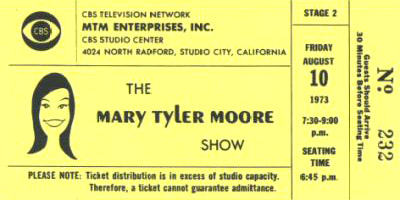
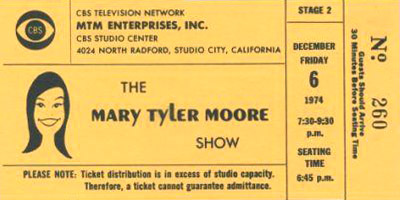
If you’d attended a filming of Ms. Moore’s classic sitcom — and sadly, I never did — you would probably have heard a warm-up performed by writer Lorenzo Music, who later gained fame as the voice of Carlton the Doorman (on Rhoda) and Garfield the Cat. For a time, shows produced by the MTM company dominated CBS Studio Center in the valley — a facility built on land that had once housed Mack Sennett’s second studio. Sennett erected it just as his business was dying out due to changing audience tastes, as well as the coming of sound film. The property was sold in a bankruptcy hearing and went through several owners before becoming Republic Studios, birthplace of many a movie serial and “B” western. It had moved into renting out space to others by 1963 when CBS leased the place, eventually buying it outright.
The Mary Tyler Moore Show was the sitcom that changed seventies’ television. As is well known, the network was not fond of the script and format devised by writers James Brooks and Allan Burns, and the advance testing of the show predicted a sure-fire flop. Less well known is how the show came to be at all. After The Dick Van Dyke Show, Mary Tyler Moore had attempted to establish a motion picture career. Thoroughly Modern Millie was a modest success but then What’s So Bad About Feeling Good? and Don’t Just Stand There suggested that ticket buyers were not racing to see Laura Petrie on the big screen. A disastrous attempt at a Broadway musical (Breakfast at Tiffany’s) also helped convince her that her place was on television. And what really convinced her (and CBS) was a 1969 special in which she reteamed with her former co-star. Dick Van Dyke and the Other Woman was an hour of songs and sketches that earned rave reviews and strong ratings.
It got Mary the offer she needed to return to the world of situation comedy and soon, she not only had a hit show but a production company that produced many of them, including spin-offs Rhoda and Phyllis, as well as acclaimed, unrelated sitcoms including The Bob Newhart Show, WKRP in Cincinnatti, The Tony Randall Show and many more. After The Mary Tyler Moore Show left the air in 1977, she again tried movies and Broadway with mixed success but again fled back to television. She starred in Mary (1978), The Mary Tyler Moore Hour (1979) and another show called Mary (1985).
That @&$# Quiz Show

John and Greg Rice were twin dwarves who were featured on several segments of Real People. Their odd but funny style caught the imagination of Real People host John Barbour, who was then sitting up his own production company and who had some limited experience with bad parody TV games. When The Gong Show started, Barbour was the host for the first week of programs taped for daytime. Producer Chuck Barris hated Barbour’s approach, junked the five shows and took over the position himself.
A few years later, operating on a shoestring budget, Barbour assembled That @&$# Quiz Show with the Rice Twins as hosts who posed very bizarre questions to very baffled contestants. Little is remembered of the show, which lasted in syndication only a few weeks in 1982. Some stations dropped it after one week. My recollection of one viewing is that the program wasn’t quite a quiz show and it wasn’t quite a spoof of a quiz show, falling uncomfortably between the two, and that the Rices tried hard but had no clue as to what they were supposed to do. The most interesting thing about the series was probably that its scenery and key art were designed by Mad Magazine cartoonist Sergio Aragonés, who had also been featured on Real People. That’s his lettering and drawing on the ticket above.
The show’s title was usually pronounced on-air with the punctuation marks replaced by a cacaphony of sound effects. When people who worked on the show gave its title, they often referred to it as That Awful Quiz Show. Most people took the easy route and never mentioned it at all.
Don Rickles Show, The
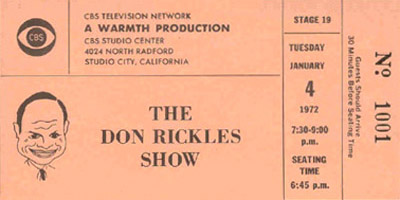
There was a time when network executives were sure that Don Rickles could be the star of a big hit TV series if only someone could find the right vehicle. In a very short time, Mr. Rickles went through more vehicles than Jay Leno has in his garage. There were pilot scripts that were filmed, pilot scripts that were not filmed, specials and even a couple of shows that made it onto the air. One attempt in 1972 basically tried to turn him into Dick Van Dyke but with a slight twist. Rickles, someone said to someone else, would articulate the anger that we all feel in day-to-day problems. So one episode was about him trying to get his TV repaired and running into bureaucracy and insane people. Another was about him trying to get his car repaired and running into bureaucracy and insane people…and so on. Otherwise, it was pretty much The Dick Van Dyke Show but without the magic.
The Rickles sitcom took place in a living room set that looked like it had been furnished by the same people who designed Rob and Laura Petrie’s home. Don Robinson had a lovely wife (Louise Sorel) who kinda reminded you of Laura, a daughter (Erin Moran) who was a lot like Ritchie, and a best friend (Robert Hogan) who had all the traits of Jerry Helper. Instead of writing The Alan Brady Show, he worked in an ad agency and instead of New Rochelle, he lived in Long Island, New York. Sheldon Leonard, who had executive produced The Dick Van Dyke Show, executive produced The Don Rickles Show. Mr. Leonard also did the audience warm-up, at least at the filming I attended, and I wrote about it in this article. In it, I also note that when Leonard wrote his autobiography years later, he discussed every TV show with which he was involved except that The Don Rickles Show went curiously unmentioned.
The series was quickly forgotten after its thirteen weeks were up. And judging from the lack of promotion it received and the fact that CBS moved it around between several less-than-promising time slots, it would seem everyone had given up on this one long before the final episode aired. Rickles wouldn’t find a decent format for television until four years later and C.P.O. Sharkey…and even that only lasted two years.
Mr. Belvedere
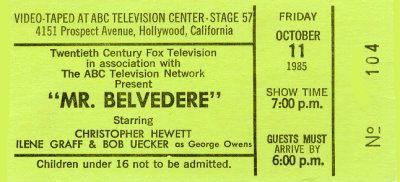
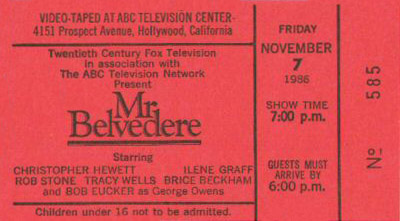
I always thought Mr. Belvedere was a stealth TV show. It was on for six seasons with respectable ratings but all during that time, I never heard one person mention it, either on TV or in my presence. Bob Uecker would go on the Carson show and casually mention his main line of work before lapsing into very funny tales of his days in baseball. (Uecker claimed to have been a lousy player who never got any respect. He didn’t get a lot in his TV career, either. On the second of the above tickets, his name is misspelled.) I don’t recall seeing any of its other stars anywhere. In fact, the only time I can recall any of my friends mentioning it was an actor pal who was up for a sitcom and who said he hoped it would be like Mr. Belvedere — a show that stays on a long time and earns its cast tons of money, and the network keeps not canceling it because even they forget it’s on. ABC Television Center at Prospect and Talmadge is in the Los Feliz area, where a lot of movie studios were built back in the silent days. This one was originally Vitagraph Pictures, but it went through many hands and remodels before becoming ABC’s main production facility in L.A. In 2000, it became a secondary site to a new studio built in Glendale, but some soap operas still tape there.
Les Crane Show, The

A radio host named Les Crane figured into ABC’s early attempts to get into the late night market. Crane’s show went for serious talk about issues in a cross between what Mike Wallace had done and what Phil Donahue would do, with much participation from a studio audience. They were seated in a kind of amphitheater formation around the stage, and if someone in the house had a question to ask or a point to make, they’d stand up and Crane would aim his “shotgun mike” at them — a microphone that actually looked like a shotgun — supposedly to pick up their voices. (Some critics suggested the device was more for theatrics than audio.)
It was a pretty good show, though sometimes a bit overly-dramatic. ABC gave up on Crane after four months, renamed the show Nightlife and tried an array of guest hosts, none of whom clicked. So they brought Crane back, added Nipsey Russell as co-host, and tried to do a more entertainment-oriented show, which did even less well. Eventually, Crane went back to radio, and The Joey Bishop Show got the time slot. The above ticket was for one of Crane’s very first shows and it displays one of the reasons his initial format didn’t work. This was a Monday-Friday show discussing what was going on in the world, right? So why were they taping it on Saturday evening? (Thanks to Brian Gari for the ticket.)






